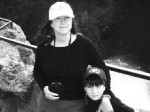Professor Column

I was hoping to see a wolf on my trip to Yellowstone National Park this fall. I thought my chances of seeing one were better than average, considering I was taking a course through the Yellowstone Institute taught by an expert in wolf biology. Nathan Varley, my course instructor, had just submitted his final doctoral dissertation on the interactions between wolves and elk in Yellowstone just eight days before meeting me and 12 other eager faces at the Slough Creek Campground near the Lamar Valley. Riding shotgun with an expert does not guarantee a sighting when these elusive canines could be anywhere in a park of over two million acres of possible habitat. Even still, the nervous chatter and positive talk did not abate after our first unsuccessful night of trying to find the wolves. After four days and no substantial sightings, seeing wolves in the wild seemed a more remote possibility.
On my fifth and last morning in the park, we set off one final time. With our spotting scopes that could magnify our targets up to forty times, we could see hundreds of bison lazily chomping on grass, young calves bustling and adolescent males head butting each other. All of these behaviors signified predators, like wolves, were not present. We moved eastward in our bus and just a few miles into the Lamar Valley we noticed a pull-off with five other cars and people with scopes all honed in on the same spot. Within seconds of stepping off the bus I heard “wolves” from the whispering voices. Fumbling with my scope, nervously setting up my tripod, I did not want to miss them.
Immediately I saw one, sitting upright – a big, black wolf. He was majestic, and he sat like a king on his haunches. His face turned toward my gaze but looked above me. Just as I was reveling in this sighting, my great luck, and his breathtaking form, another black wolf approached him. The second wolf licked his jowls and began pacing around him. Then another black wolf strolled into my field of view. Whispering revealed that these were from the Druid Pack. I heard more whispering about two gray wolves. Against the dull background of sagebrush and aspen, and the first light of day, I had trouble seeing the grays at first.
Then I saw the alpha female. Striking grace billowed from her silver form, black markings on her shoulders, tail and ears rippled as she paced. She began to howl. The five howled in unison at times, then took turns facing each other, howling, and pacing. I sensed discontent in their howl and yet it filled my heart with joy to hear it.
It took me a few moments to register that I was also hearing a howl from behind me. Not 100 meters away, a lone black wolf sat on the hillside across the road and howled back. A moment later, I realized a second gray wolf sat silently next to him. I watched the wolves deliberate from afar. Those across the valley wanted their companions to come, but the two on the hillside were reluctant to cross the road near the humans. Across the valley five wolves became nine, and when they became 11in total, a short-lived reunion ensued. Some yipping and face licking, excited greetings, and then all of the sudden it was settled.
The pack of 11 moved east leaving the two on the hillside behind. The two wolves disappeared to the back side of the hill.
Without discussion, they trotted in a line, down the valley toward a herd of bison. The bison seemed unconcerned for the most part, except for a few of the calves that looked as if they had been stung by a bee on the rump as the wolves came near them. The young ones clumsily galloped to their parents. Four of the wolves surrounded one of the largest males in the herd. To show his disdain for these canines, the bull snorted then rolled over and took a dirt bath in front of them. The wolves sauntered onward.
The Druid Pack was in motion for about two miles. We followed them, keeping a distance of about a mile and then they stopped. A few of the wolves continued to pace around the pack, but several bedded down, and two sat upright keeping watch. The pack seemed resigned to wait at this spot.
Minutes later, we heard a female voice over the radio say “They’re crossing the road. There are six of them. It’s the pups.” Our group became silent. Autumn can be a dangerous time for the pups. They’re too big to feed only regurgitated meat, too curious to stay in one place, but too little to really keep up with the adults. The pups often lag behind the pack when they travel and on this morning, daylight caught them on the wrong side of the road.
I couldn’t see them crossing. The pups were in a dip in the valley but I could see the intensity of the 11 as they watched their young ones approach. As the first of the six pups reached the pack, mayhem broke out. I could hear the yelping and yipping a mile away and I watched as tails wagged and they leaped over each other to get in on the greeting.
Faces, tongues, and teeth collided and fur literally flew. There was wrestling and pawing as shear joy and relief spread over the pack and over those of us watching. And with the suddenness of a dinner bell, they all agreed it was a good time to leave. As I watched the last one sprint up the hill and disappear into the long leaf pines and aspens, the radio broke the silence and peace of that moment. “Did you see the seventh pup?” a woman asked. Nathan answered, “I only saw six.” It was clear that the pack was not expecting the seventh pup. Somewhere between today and the last time the pack was sighted, the seventh pup became part of the cycle of life in Yellowstone National Park.
Everyone shared a speechless moment as we gathered back on to the bus. Two hours of wolf watching filled my spirit. Watching discontent turn to joy in these wild canines revealed a caring family unit – not some marauding gang of bullies as they’re portrayed in myth and rumor. Some biologists say animals don’t feel emotions. I don’t think they’ve seen wolves.
Cynthia Moulton is an Associate Professor of Biology in the Natural Science Department and she highly recommends the courses offered by the Yellowstone Institute. For more information see http://www.yellowstoneassociation.org/institute/.





